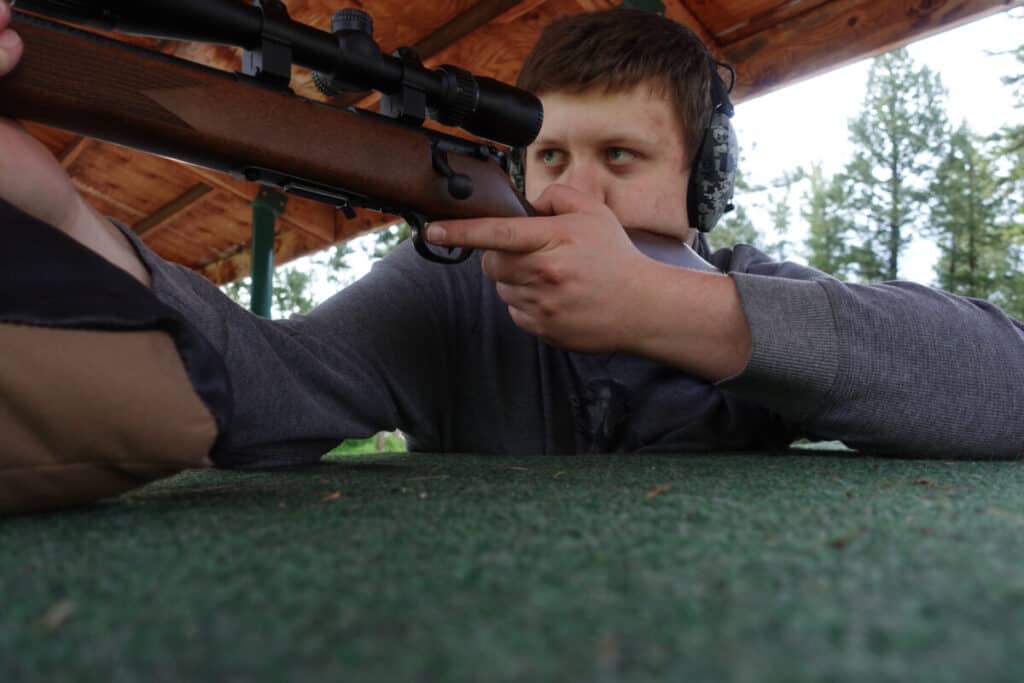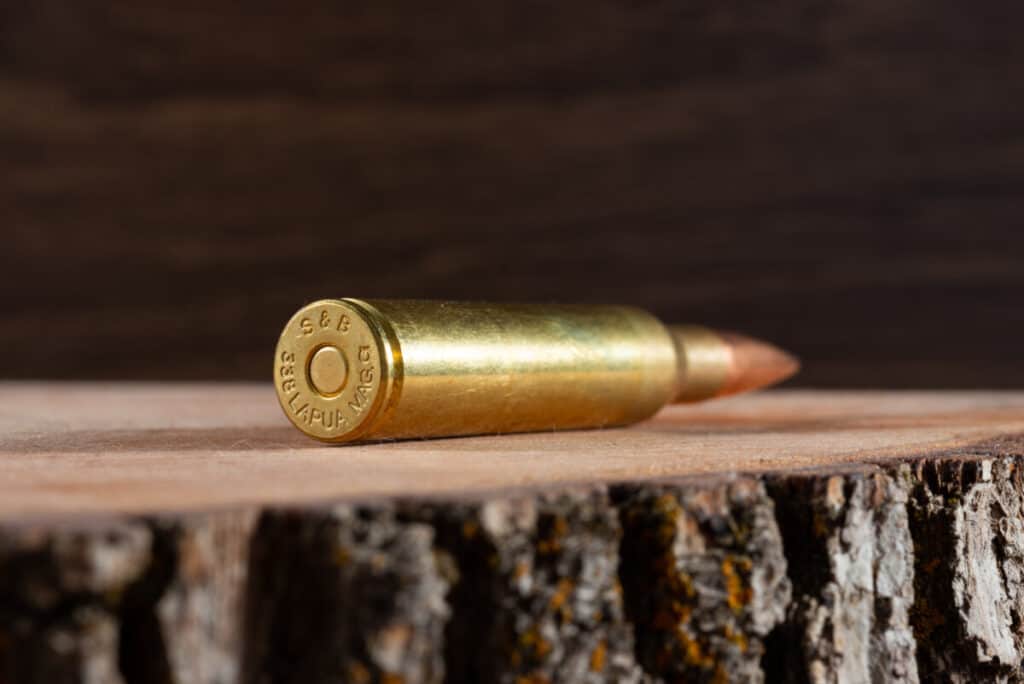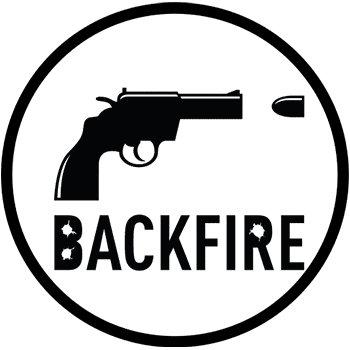How to Tell If Your Gun is Rimfire or Centerfire

Does your gun shoot rimfire or centerfire cartridges? First and foremost, only fire the cartridge that your gun is chambered for.
You can differentiate between a centerfire and rimfire gun by looking at the base of the cartridge it shoots. If there is a circular primer in the middle, it is a centerfire cartridge. Rimfire guns shoot a primer that is packed around the edges of the case, so no primer pocket is visible.
Some guns will simply have the cartridge name stamped on the barrel, perhaps it says .270 Winchester, or 22LR; while some will be more specific and say “only”, as in 300 Weatherby Mag only. This may ease some confusion as there are many cartridges in the world that house the same caliber projectile.
Examples are guns that fire .30 caliber and may be marked as 300, such as the 300 Winchester Magnum, 300 Savage, 300 Winchester Short Magnum or 300 H&H magnum, among others. If you were to peruse a well-stocked ammunition shop looking for 6.5 Creedmoor ammunition, you may find a slew of 6.5 ammo in the same area. There is a vast difference between 6.5 Creedmoor, 6.5 PRC, 6.5 Grendal, 6.5×55 Swedish, etc.
Again, it is imperative that you only attempt to fire the exact cartridge your gun is chambered for. Yes, the barrel may be .30 caliber, but each cartridge is different and requires exact fitting or headspacing. A cartridge fits into the chamber exactly, just beginning to reach the rifling with the projectile.
This is not to say that every single firearm only shoots one cartridge, as some rimfire rifles may shoot as many as three different .22 caliber cartridges. I have an old Winchester rimfire rifle that can shoot .22 short, long or long rifle. These types of guns are the exception, not the norm.
What Will Happen If I Chamber a Cartridge Not Designed For My Gun?
If you were able to fire your gun with the wrong cartridge chambered, you can expect either catastrophic weapons failure, injury to the shooter and those around the shooter, or possibly death.
If you were to attempt to chamber an incorrect cartridge in your gun you will find that it likely will not fit. Perhaps you cannot close the bolt of your rifle, or you may feel as though you are forcing the action closed. This would be an indicator of something very wrong. You will find that with the correct cartridge for your gun, the action should close with minimal effort.
Let’s say you did manage to close the action on an incorrect cartridge for your gun, some very bad things will happen. First, you may have jammed an incorrect cartridge into your gun’s action and likely won’t be able to extract it yourself. A trip to your gunsmith is imminent-and this the best case scenario.
When the firing pin or hammer hits the primer or rim of a cartridge, it causes a chain reaction within your gun. First, the priming agent ignites causing the main powder charge in the cartridge to also ignite. This mini-explosion inside your gun’s chamber expands the brass case of the cartridge, sealing it even tighter within the chamber of the gun. The gases must go somewhere and they propel the projectile towards the path of least resistance-down the barrel.
Firing the wrong cartridge in your rifle means the seal between brass and chamber is imperfect, and would allow those gases to escape via other avenues than just the barrel. Those gases may destroy your firearm, and likely harm you. This doesn’t even take into account the projectile caliber. Even projectiles of the same caliber as those your gun is chambered for can cause catastrophic ruptures of the barrel if not properly headspaced.

Be mindful when buying ammunition for your gun, ensure that you buy only the ammunition your firearm is chambered in. When practicing at the range, always wear hearing and eye protection.
Determining If Your Gun Is Chambered For Rimfire or Centerfire
If you are not familiar with the countless different cartridges out there, both rimfire or centerfire, you can still tell by looking at your firearm. Always remove any ammunition or magazines from your weapon and ensure both visibly and physically that your firearm is unloaded. Once you lock your action open you may look at the bolt face of your gun.
The bolt face of your gun allows the firing pin or hammer to impact the back of the chambered cartridge. Centerfire cartridges house a primer in the very center of the rim, and the firing pin of centerfire rifles will impact the cartridge through a hole in the center of the bolt face. Rimfire cartridges are designed to be struck on the edge of the rim and the firing pin hole will be found towards the edge (off-center) of the bolt face.

List Of Rimfire Cartridges
- .17 HMR (Hornady Magnum Rimfire)
- .17 Mach 2
- .17 WSM (Winchester Super Magnum)
- .17 Aguila (considered obsolete)
- 5mm Remington Rimfire Magnum
- .22 Long
- .22 LR (Long Rifle)
- .22 Short
- .22 Shotshell Rimfire
- .22 WMR (Winchester Magnum Rimfire
- .22 CB
- .22 Winchester Automatic (only for Winchester Model 1903 semi-automatic rifles)
- .22 WRF (considered obsolete)
- 9mm Flobert (Shotshell)
If your gun is stamped with any of the aforementioned chamberings, then it shoots a rimfire cartridge. If it is not on that list, it is almost certainly a centerfire cartridge. By far, the majority of hunting rifles are chambered in centerfire cartridges.
There are plenty of old, obsolete rimfire cartridges as well; if your gun is chambered for one of them, look for rimfire in the name. An example: .32 Long Rifle Rimfire
Pros and Cons of Rimfire Cartridges
Pros:
Rimfire cartridges are excellent rounds for beginners, as they have minimal recoil or report, allowing novice shooters comfort while learning shooting fundamentals.
In my years as a firearms instructor, the most common mistake I have noticed among new shooters is anticipation of the recoil. Generally, this will force the novice shooter to dip the gun just before it is fired, in a futile hope of fighting recoil. The lack of noticeable recoil from rimfire guns alleviates this malady.
Rimfire rounds may be used to hunt small game such as squirrels, rabbits and groundhogs; therefore, rimfire guns make great first guns for our young burgeoning hunters.
Rifles chambered for rimfire cartridges are generally less expensive than centerfire rifles.
Rimfire ammunition is relatively inexpensive.
Rimfire rifles are frequently used in competitions.
Cons:
Rimfire cartridges are more limited in range than centerfire cartridges, offer less energy upon impact and are ineffective on larger game species.
The rimfire cartridge ignition system is not as effective as those of centerfire cartridges, potentially creating a greater chance for misfire.
You cannot reload rimfire cartridges.
Rimfire guns are not generally used or effective as self defense weapons.
Pros and Cons of Centerfire Cartridges
Pros:
Centerfire cartridges are more accurate at longer ranges and offer enough energy to hunt every species of game animal on the planet.
There are a diverse amount of centerfire cartridges, allowing the shooter to select the rifle and cartridge that best fits their needs.
The higher velocities produced by centerfire cartridges make for a flatter shooting, more accurate round.
Centerfire ammunition, which uses a separate primer component, is more reliable.
Centerfire cartridges are readily reloadable, allowing the reloader an array of projectile options for custom-like ammunition.
Because of the lethality of centerfire cartridges, they are often used for home or self defense.
Cons:
Rifles chambered for centerfire cartridges are more expensive than those chambered for rimfire.
Centerfire ammunition is more expensive than rimfire ammo.
Centerfire rifles recoil harder, and the noise level of the report is louder.
Centerfire rifles are heavier, often with longer barrels to maximize the centerfire cartridge’s potential, making them less easy to wield-particularly for younger or smaller shooters.
Why Is Rimfire Ammunition Cheaper Than Centerfire Ammunition?
The easiest answer to this question is that there is quite a bit more material in centerfire ammunition than rimfire ammunition.
To illustrate: a 40 grain .22 long rifle rimfire cartridge weighs .116 of an ounce, while a 55 grain .223 Remington centerfire cartridge more than triples that number, weighing .374 of an ounce.
The .223 Remington is on the small side of centerfire cartridges, and the overall weight of the cartridge grows exponentially as the caliber and cartridge size grows. There are many larger centerfire cartridges that weigh over an ounce.
The amount of material is not the only answer to this question. Rimfire cartridge production is more straightforward (though not easier) than production of centerfire ammunition. With rimfire cartridges the priming agent is impelled into the hollow rim of the one piece case before the main powder charge is added and topped with the bullet.
Centerfire cartridges utilize a separate primer which is seated into an opening on the rim of the brass case, before the main powder charge and bullet are installed. Both the primer and brass must be manufactured separately before completing the cartridge with the other components.
Many centerfire ammunition companies outsource their primers as well as the propellants needed for ammunition manufacturing.
Do I Have To Make A Choice?
Since rimfire rifles and ammunition are so relatively inexpensive, (some rimfire guns cost less than $200.00) and offer true value as an introductory gun, training device or varminting tool; even a big game hunter can and should have access to a rimfire gun.
If you are new to shooting, a rimfire is an excellent choice to learn with. Not to suggest that a rimfire is similar to training wheels for bicycles; they are indeed capable of inflicting harm to humans and animals alike.
I began my shooting career with a .22 long rifle rimfire and still own that gun. I still take it to the range and practice with it and use it to hunt squirrels and rabbits to this day. I find so many benefits with rimfire guns I have since purchased another, more modern rimfire rifle.
When you consider the amount of trigger time you can afford with the price of rimfire ammo, the original purchase price of a rimfire gun, and the value practicing with rimfire guns offers to shooters, they truly are a great investment.
